Hi there, I wanted to share a method that I came up with to clean up some dirty ISO oil that had warmed above freezing during the soak and rapidly got quite dark (material was chopped too fine, absorbed too much isopropyl, required to be wrung and warmed during this time spent outside the freezer...).
After a few days spending free time searching for methods for clean it up, the working methods I could find that do not require significant investments in equipment were limited to performing a hexane/alcohol wash (very effective but hexane is unavailable locally), UV photobleaching (only works on light chlorophyll contamination, doesn't touch waxes), water [and saturated saltwater] rinsing (does not touch waxes and removes terpenes better than the chlorophyll) and winterizing/filtering. I had already winterized the oil in an alcohol solution for 48 hours then decanted and ran it through a 5 micron filter before reducing it back to oil but it was still a long way from acceptable.
I started wondering if butane could be used to extract from.. an extract.. as it is non-polar I figured that it should be able to achieve similar results as with using hexane. To my surprise I couldn't find any mention of someone doing this after a somewhat thorough search, so I decided to give it a try.
After determining that the pressure of butane is 17 PSI @ 70 degrees F and 23 PSI @ 80 degrees F (falling to ~0 pressure at around 32 degrees F), I found a bottle pressure rated for 55 PSI. To reach the bottle's rated limit the butane would need to reach 120 degrees F, far hotter than it will ever get in this environment.
I performed this directly in front of an open door with an intake fan on the other side of the house creating a constant pressure exiting through the door behind me, while wearing leather gloves and safety goggles. After transferring the oil to the bottle, it was filled a bit more than halfway with butane, the cap was closed and I tilted the bottle from side to side to spread the oil across the inside surfaces to expose as much surface area as possible to the butane... then let it sit in a cool area for a half hour, agitated the bottle again to expose fresh surface area to the butane and let it sit for another half hour before shaking it well a final time before putting it in the freezer to depressurize.
I had tried this same procedure but instead having the bottle in the freezer the entire duration of the soak but it did not extract nearly as much (I suspect the oil at that temperature is too stiff to flow and restricts access to the butane from contacting much of it's surface).
After chilling for an hour or two the bottle was well under 32 degrees as evidenced by the frost accumulating on it after removing from the freezer so I prepared a filter, gave it one last good shake and slowly opened the cap then affixed the filter across the opening with a rubber band before pouring the butane in to a baking dish to evaporate off.
The first three pictures are the dirty oil before the procedure, the last three show what came out from the butane compared to what was left in the bottle. The material in the bottle had an interesting rubbery consistency with a subtle grey coloration to it.. yuck
 I ran the butane through the bottle again and it did manage to pull a bit more out of it with the same quality as the first run. As you can see the processed material is *much better*.
I ran the butane through the bottle again and it did manage to pull a bit more out of it with the same quality as the first run. As you can see the processed material is *much better*.
Using ISO to extract from large amounts of trim or even straight leaf is far less expensive than using butane (which may cost more than the oil is worth, if using straight leaf) and this allowed me to cheaply extract and then easily refine using only a can or two of butane. Certainly it would be best to have a perfect run of chilled ISO without needing clarifying, but sometimes things don't always work out the way you expect them to. Hopefully this process helps a few people out.
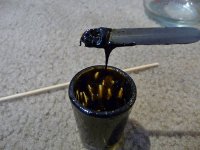
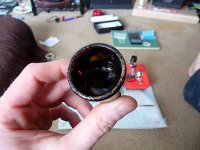
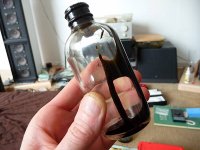
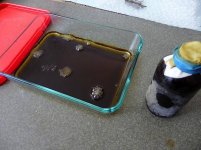
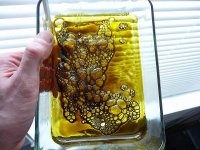
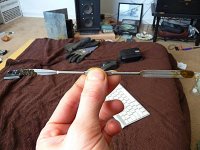
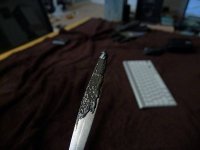
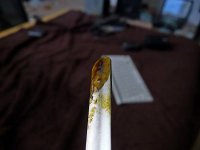
After a few days spending free time searching for methods for clean it up, the working methods I could find that do not require significant investments in equipment were limited to performing a hexane/alcohol wash (very effective but hexane is unavailable locally), UV photobleaching (only works on light chlorophyll contamination, doesn't touch waxes), water [and saturated saltwater] rinsing (does not touch waxes and removes terpenes better than the chlorophyll) and winterizing/filtering. I had already winterized the oil in an alcohol solution for 48 hours then decanted and ran it through a 5 micron filter before reducing it back to oil but it was still a long way from acceptable.
I started wondering if butane could be used to extract from.. an extract.. as it is non-polar I figured that it should be able to achieve similar results as with using hexane. To my surprise I couldn't find any mention of someone doing this after a somewhat thorough search, so I decided to give it a try.
After determining that the pressure of butane is 17 PSI @ 70 degrees F and 23 PSI @ 80 degrees F (falling to ~0 pressure at around 32 degrees F), I found a bottle pressure rated for 55 PSI. To reach the bottle's rated limit the butane would need to reach 120 degrees F, far hotter than it will ever get in this environment.
I performed this directly in front of an open door with an intake fan on the other side of the house creating a constant pressure exiting through the door behind me, while wearing leather gloves and safety goggles. After transferring the oil to the bottle, it was filled a bit more than halfway with butane, the cap was closed and I tilted the bottle from side to side to spread the oil across the inside surfaces to expose as much surface area as possible to the butane... then let it sit in a cool area for a half hour, agitated the bottle again to expose fresh surface area to the butane and let it sit for another half hour before shaking it well a final time before putting it in the freezer to depressurize.
I had tried this same procedure but instead having the bottle in the freezer the entire duration of the soak but it did not extract nearly as much (I suspect the oil at that temperature is too stiff to flow and restricts access to the butane from contacting much of it's surface).
After chilling for an hour or two the bottle was well under 32 degrees as evidenced by the frost accumulating on it after removing from the freezer so I prepared a filter, gave it one last good shake and slowly opened the cap then affixed the filter across the opening with a rubber band before pouring the butane in to a baking dish to evaporate off.
The first three pictures are the dirty oil before the procedure, the last three show what came out from the butane compared to what was left in the bottle. The material in the bottle had an interesting rubbery consistency with a subtle grey coloration to it.. yuck
Using ISO to extract from large amounts of trim or even straight leaf is far less expensive than using butane (which may cost more than the oil is worth, if using straight leaf) and this allowed me to cheaply extract and then easily refine using only a can or two of butane. Certainly it would be best to have a perfect run of chilled ISO without needing clarifying, but sometimes things don't always work out the way you expect them to. Hopefully this process helps a few people out.










